The 2012/13 season was the last time a team than RB Salzburg had won the Austrian Bundesliga as Austria Vienna under their coach Peter Stöger ended that campaign in first place. Now, seven years later, Austria Vienna is far away from the race for the championship as they sat ahead of this match in the seventh position. After this game, there are only two games left until the 12 clubs of the Austrian Bundesliga get divided into two groups and each team battles for the championship and not to be relegated respectively. Ahead of this clash, Austria Vienna sat six points behind Hartberg who are in the sixth position, and so the last place in which it was possible to be part of the championship round.
On the other side, RB Salzburg won after the return from the winter break just their first match against Amstetten who are in Austria’s second division, then lost against LASK Linz and Eintracht Frankfurt in the UEFA Europa League. Because of the defeat against LASK, they were ahead of this match with one point behind the league leaders Linz and due to the 4-1 loss against the Bundesliga club Frankfurt, the chance to get into the last round of 16 in the UEL which is not that big anymore. Still, it would be wrong to say that Salzburg are in a crisis, but one has to admit that their performances aren’t as dominant as we were used to.
In this tactical analysis, we’ll look at both teams’ tactics and explain why RB Salzburg were once more not able to get a win as the game ended 2-2.
Lineups
The home side used a 4-2-3-1 formation in this game with Patrick Pentz in goal and the back four was made of Andreas Poulsen, Erik Palmer-Brown (on loan from Manchester City), Michael Madl, and Florian Klein. The captain Alexander Grünwald and Aleksandar Borković were the two defensive midfielders in front of the back four while the number 10 was Dominik Fitz. The wingers were Manprit Sarkaria and Benedikt Pichler while Christoph Monschein was the lone man up front.
Jesse Marsch lined his team up in a 4-2-2-2 and 4-4-2 (with narrow positioned wingers) respectively. Cican Stankovic was the goalkeeper while the central defence was made of Maximilian Wöber and Jérôme Onguéné. The full-backs were Andreas Ulmer and Albert Vallci. The central midfield got occupied by Majeed Ashimeru and Mohamed Camara and the more advanced midfielders were Masaya Okugawa and Mergim Berisha. Up front, we had the duo of Patson Daka and Hee-chan Hwang as the two strikers once more, both of whom were until now in every single game since Erling Haaland’s move to Borussia Dortmund.
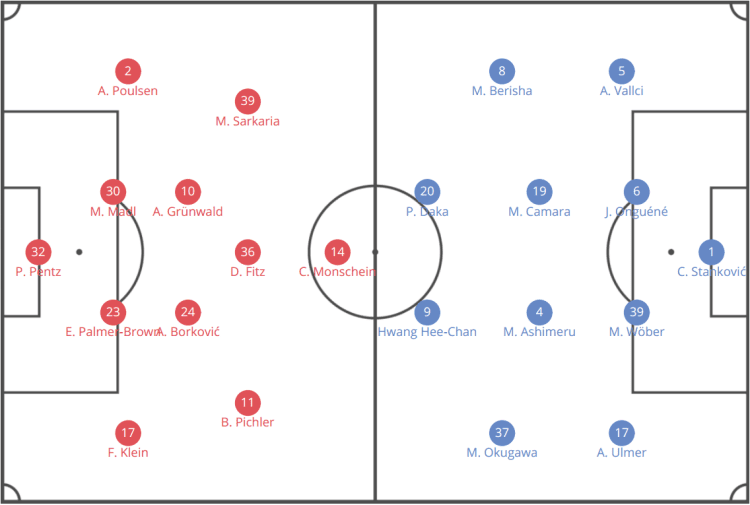
Salzburg’s different build-up patterns
In the first fixtures after the winter break against Amstetten and against LASK last week, the team of Marsch played with a back three while against Frankfurt and in this match, we saw a system with a back four. In any case, they had neither Enock Mwepu nor Zlatko Junuzović in the central midfield who are usually the first-choice players of Marsch in this position. Instead, he wanted to give them a break ahead of the second leg against Eintracht Frankfurt.
Still, it was quite interesting to watch Salzburg during the build-up since they permanently changed their positionings during the first stage of the attacks. While Austria Vienna mostly put pressure about at them at the height of the half-way line or a few yards higher, Salzburg had usually time and space to circulate their ball in their own half. Of course, in some situations, Austria pushed forward and used a higher pressing, but this was just occasionally as mainly they defended in a mid-block which transformed in a low block when Salzburg were able to get forward as we’ll see later in this tactical analysis.
During the first phase of the build-up, they used three different patterns and positionings of the players. While Daka and Hwang stayed upfront centrally near the opposition’s centre-backs and Berisha as well as Okugawa were a bit deeper and in the half-spaces, the two defensive midfielders and the back four switched in almost every new attack their formation.
In some situations, they created a back three as Camara dropped next to the two centre-backs on the rights side what is logical as he was the right defensive midfielder. In these situations, the left centre-back Wöber positioned wider and Onguéné was the central man while the full-backs positioned higher and Ashimeru was the lone man in the central midfield as we can see below.
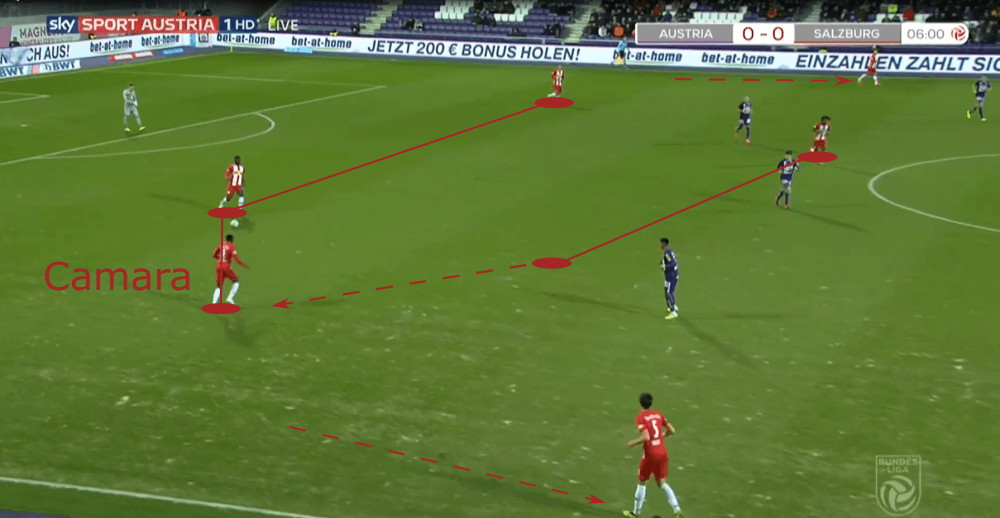
However, it was not determined that Camara would always be the one who drops deep as Ashimeru also made this movement in several situations as he was positioned next to the left centre-back Wöber which led to a wider positioning of Onguéné. Again, Ulmer and Vallci were positioned higher while this time Camara was the one lone man in front to the back three. We can see this mechanism perfectly in the shot below as Camara wants to drop to create a back three, but while he is on his way back, Ashimeru does the same on the other side and due to that, Camara has to sprint into the centre to occupy the space in the middle.
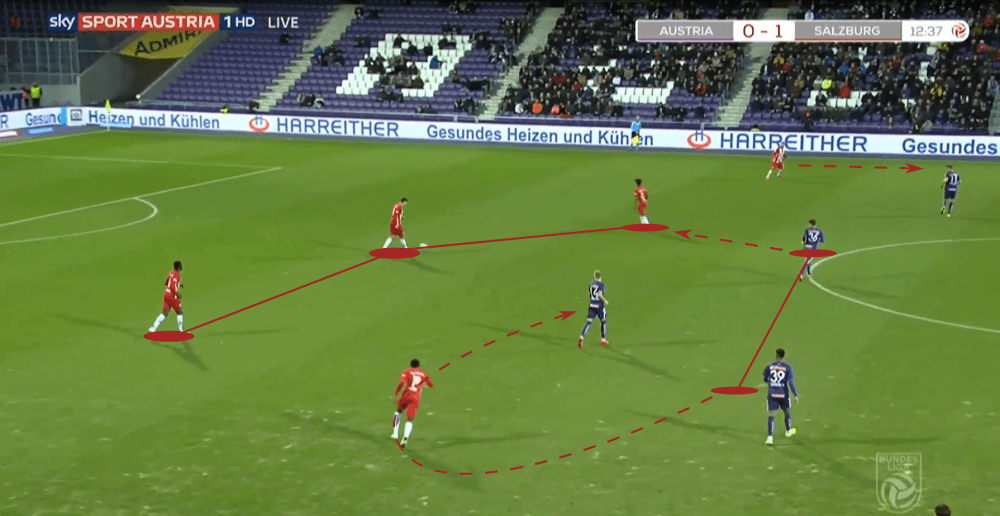
The third pattern already tells how the attacks of Salzburg looked like in the higher areas: central orientated. The last mechanism was that the two defensive midfielders both would stay in their positions ahead of the back four, but this led to a less wide position of the full-backs. This was especially the case with Vallci who is, in truth, a centre-back often positioned too narrow and didn’t stretch the opposition at all as we can see below. In these situations, he made it easy for Austria Vienna to put pressure on RB Salzburg with his positioning as they didn’t use the full width of the pitch.
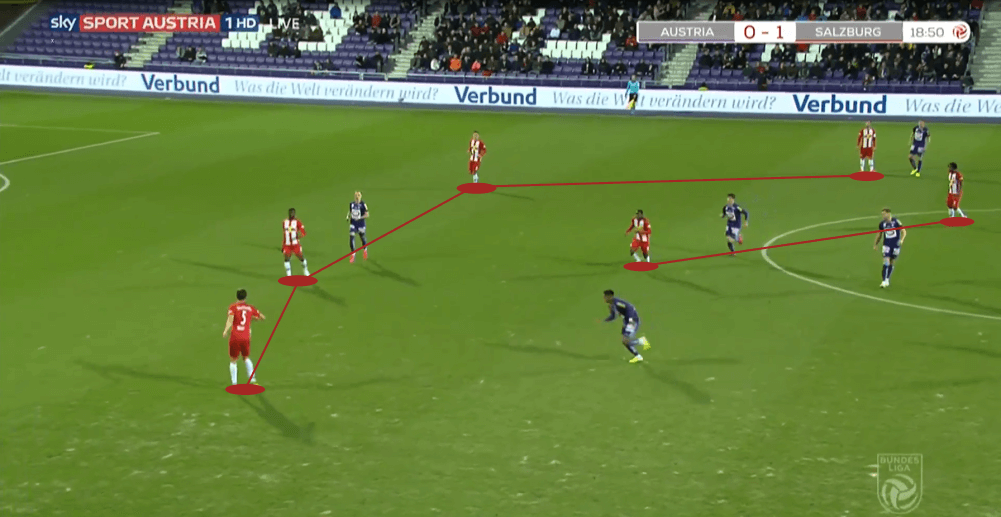
On the other side, you have to give huge credit to Vallci who assisted the 1-0 of Daka with a great cross. However, ahead of his delivery, he was positioned extremely wide and high up the pitch to have the necessary space and this was only possible as ahead of that moment Camara dropped deeper to create the back three which allowed Vallci and Ulmer to position higher.
As we will see in the next paragraph of this tactical analysis and already noticed in Salzburg’s last build-up pattern, Marsch’s team rarely used the full width of the pitch during their attacks. Due to that, they made a change in the 74th minute and brought on Patrick Farkas for Hwang. Therefore they switched to a 3-4-1-2 which is usual for them and constantly build up from behind with the back three of Wöber, Onguéné, and Vallci while the wing-backs Farkas and Ulmer and the two central midfielders Ashimeru and Camara constantly stayed in the space ahead of the back three.
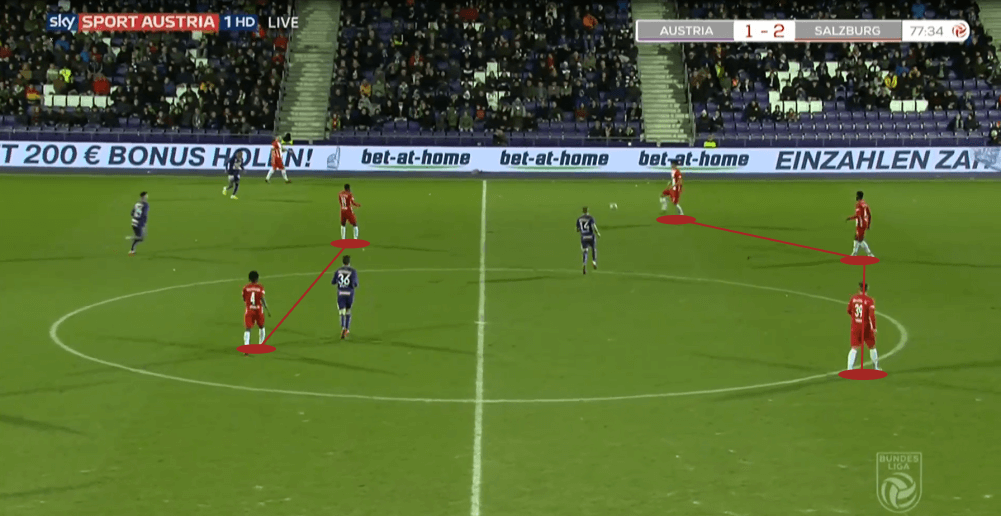
Both teams concentrate on the centre
One of Salzburg’s greatest problems in this match was that they rarely used the full width of the pitch and focused on the attacks through the centre. Since sometimes no single player was positioned on either wing, Austria Vienna didn’t necessarily need to occupy these wide-areas and due to that also just focused on preventing attacks through the centre. The team of head coach Christian Ilzer switched in these moments from a 4-2-3-1 to a 4-4-1-1 and in truth, the only difference is that the wingers dropped back about on the height of the two defensive midfielders. The number 10 Fitz stayed slightly ahead of these two banks of four while Monschein stayed up front and we’ll look at his role in Austria Vienna’s tactics later on with more detail. Notice below how narrowly they are positioned since Ulmer is the only one who is positioned at least a bit wide on the left wing while all other players of Salzburg stay in the centre.
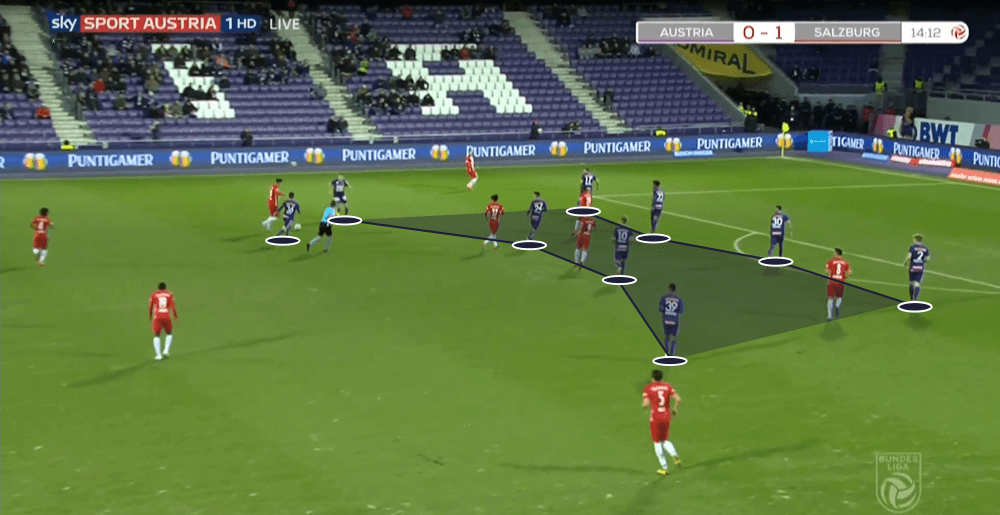
Besides the high pressing and the counter-pressing which they executed in this game, RB Salzburg is also well-known for their combinations of short passes in the final third and especially in zone 14. As soon as they come near this area or enter it, they try to get behind the last line of the opposing defence and the penalty box respectively to create a goalscoring chance. Since they played in this game with four central-orientated midfielders and additionally two strikers, you would expect them to easily have enough options in the centre to break through with short passes.
However, since they rarely occupied the wide areas, their opponents also stayed narrow and due to that a lot of bodies were in the central area of the pitch. This meant that RB Salzburg rarely were able to break through. Notice below how many players are in the centre while both wings are vacant.
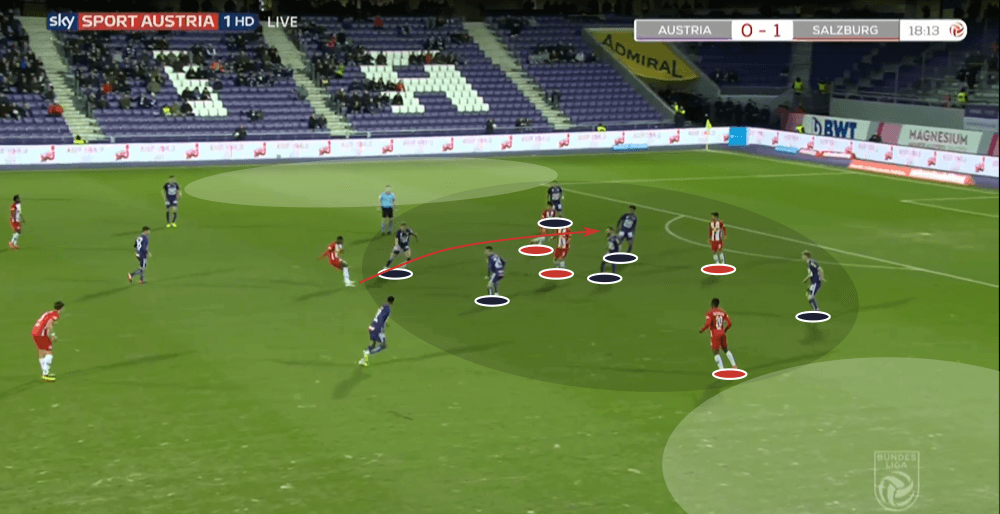
Christoph Monschein’s importance
As already described above in this tactical analysis, Austria Vienna usually stayed in their 4-4-1-1 system and put pressure on their opponents at about the half-way line and sometimes also deeper when they sat back with their two banks of four. In such situations, they also lured out their opponents which gave them more space during the moments of offensive transition.
In these situations, the single striker Monschein was extremely important as he didn’t just stay up front to wait for the long ball, but moved to one of the two wide areas to receive a pass, lay it off, and immediately sprint forward again. Besides, due to his runs to the wings during the first seconds of the counter-attack, he forced one of RB Salzburg’s centre-backs to follow him which created space in the centre. In the image below we can see a typical example as he moved to the left wing to receive the first forward pass during the counter-attack and he lays it off with his first touch.
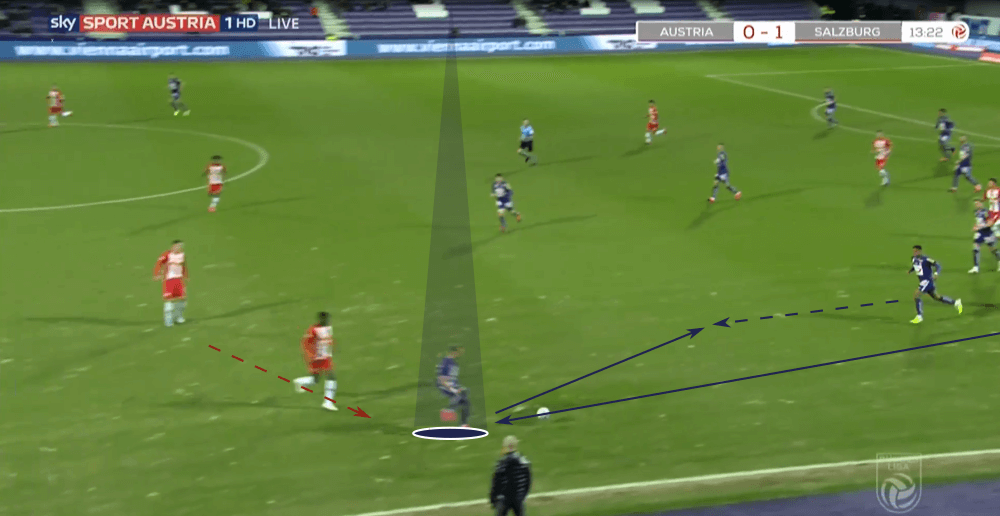
It was not just during the counter-attacks, but also during the build-up that they often wanted to find Monschein up front so he can lay the ball off for his teammates. Austria Vienna also operated in this game with quite a lot of long balls due to Salzburg’s high pressing. In such moments, Monschein positioned on the right wing since it was there that he and Pichler got into aerial duels with Ulmer who is clearly the weakest in the air of Salzburg’s back four.
Also, since the left-back Poulsen can throw in the ball over a long distance, Vienna often tried to use these throw-ins and find Monschein who then would either stay on the ball or pass it to one of his teammates who can rush forward from a deeper position as we can see below.
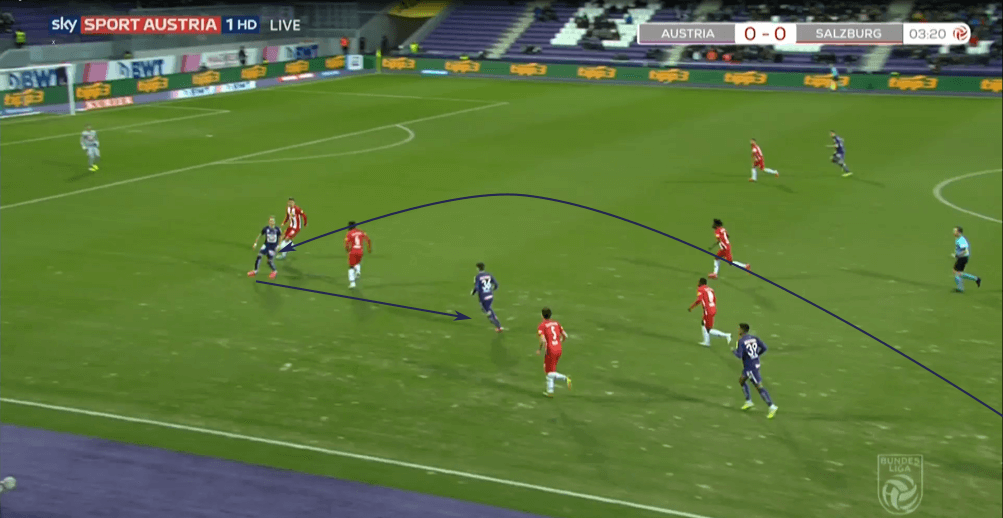
The 27-year-old Austrian striker is not just Vienna’s most dangerous offensive player (after this game he had 15 goals in 20 appearances) but is in general important for the creation of goalscoring chances. Since he is the only striker in the system of his coach Ilzer, we can see him often alone up front on the ball, waiting for his teammates to start deep runs from deeper positions and then he tries to find them with through passes, as in the example below where he finds Grünwald with a backheel pass.
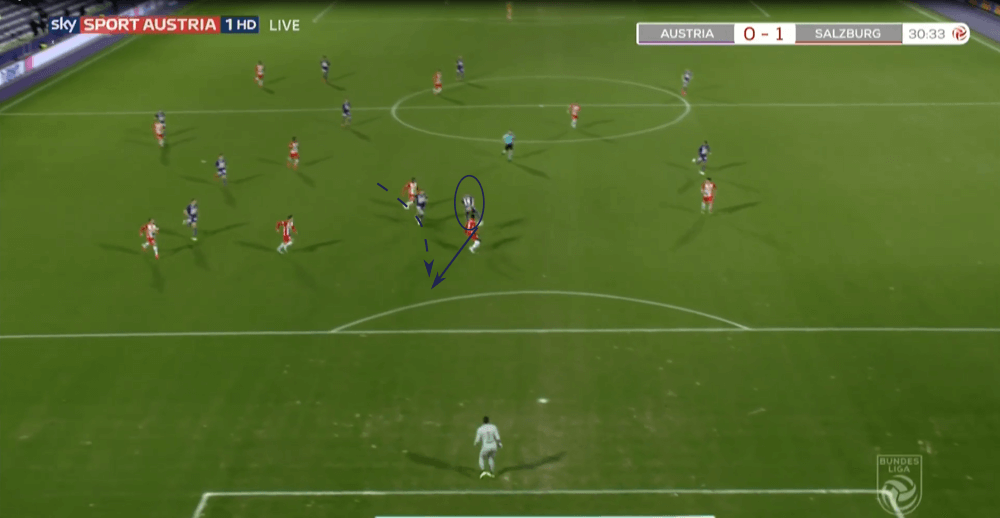
What is Salzburg’s greatest defensive issue?
In the last three games against LASK, Frankfurt, and Austria Vienna, RB Salzburg conceded all in all nine goals which means an average of three goals against them per game. On the other side, they conceded ahead of the winter break in the Austrian Bundesliga and the UEFA Champions League 31 goals in 26 fixtures (1.19 per game). So we can see that they clearly have some defensive problems at the moment.
Of course, they lost some important players in the winter transfer window and the departure of Marin Pongračić especially hurts them. However, it is quite noticeable that they concede clearly too many goals after set-pieces. Against Linz, two goals of the opposition happened after throw-ins, in the match against Frankfurt the team of Adi Hütter scored one goal after a throw-in, and in this match, Vienna scored the 2-2 after a corner.
However, it’s worth adding that in this game against Austria Vienna, Salzburg had again problems when the opponents brought the ball into the centre with a throw-in as we can see below.
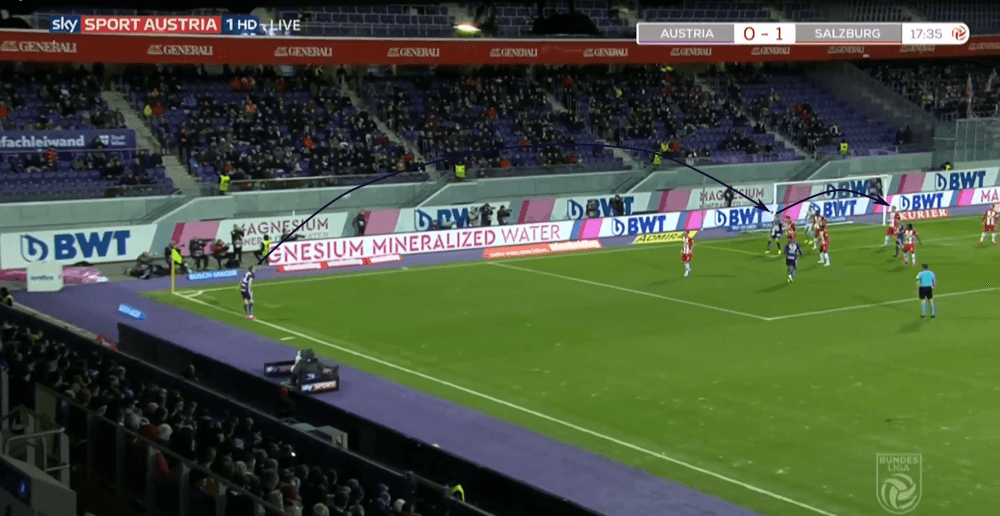
Austria Vienna scored the equaliser and last goal of the match in the 89th minute after a corner which was delivered by Fitz and the centre-back Palmer-Brown scored with a great header as he was completely free. The team of Marsch uses zonal marking ahead of the corners as we can see in the first image below (five players in one line in front of the goal and five players in front of them to block the way for the opponents). However, it didn’t work once more as Palmer-Brown and Borković are completely free just a few yards in front of the goal. Notice the red space in the first image as their seconds later Palmer-Brown and Borković are completely free.
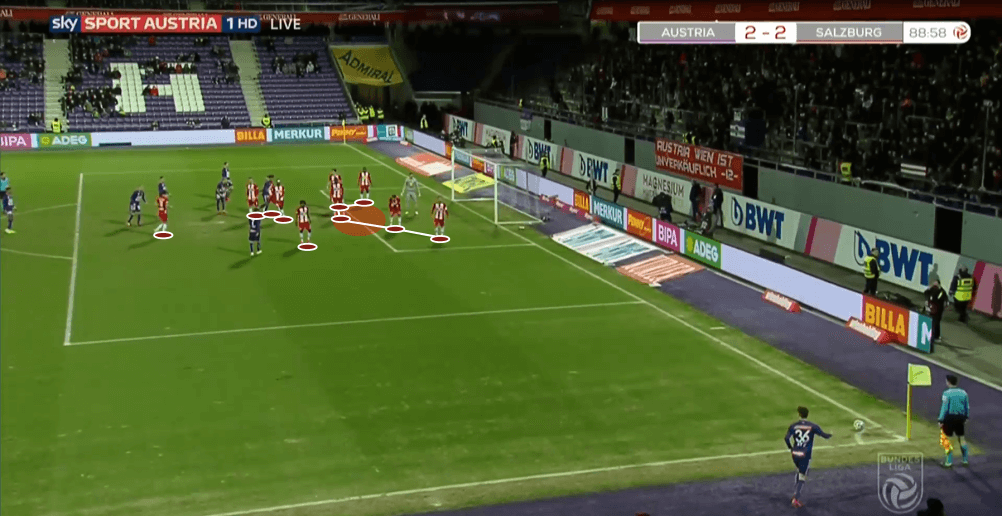
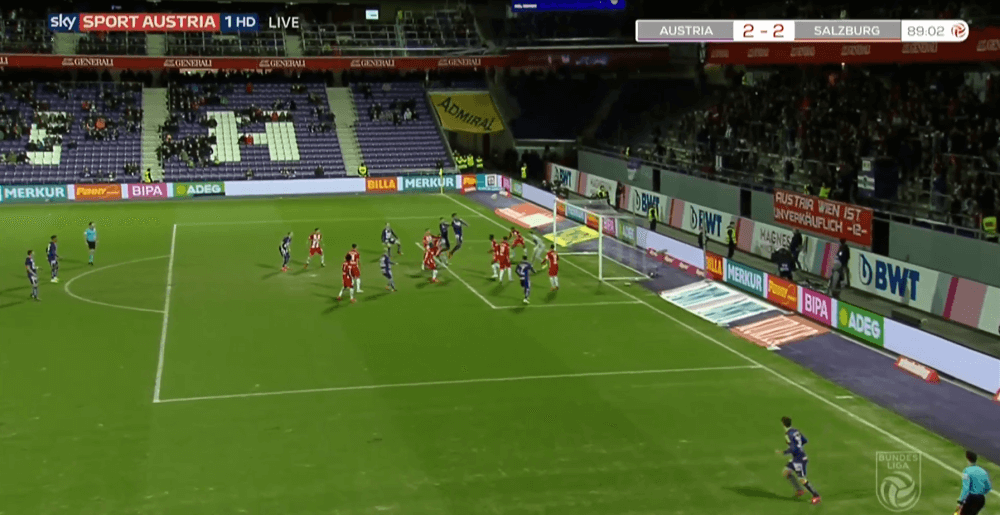
Conclusion
Since LASK Linz won this weekend with 4-1 against St. Pölten, RB Salzburg are currently three points behind the league leaders while Austria Vienna are six points behind Hartberg and there are just two games left. In light of this, the draw helped neither Salzburg nor Vienna.
Since Salzburg concentrated so extremely on the centre during their attacks, it was not too difficult for Austria Vienna to defend against them and the team of Marsch once more gave away points due to a goal which resulted from a set-piece whilst also not bringing them that much confidence back ahead of the second leg against Frankfurt.





Comments